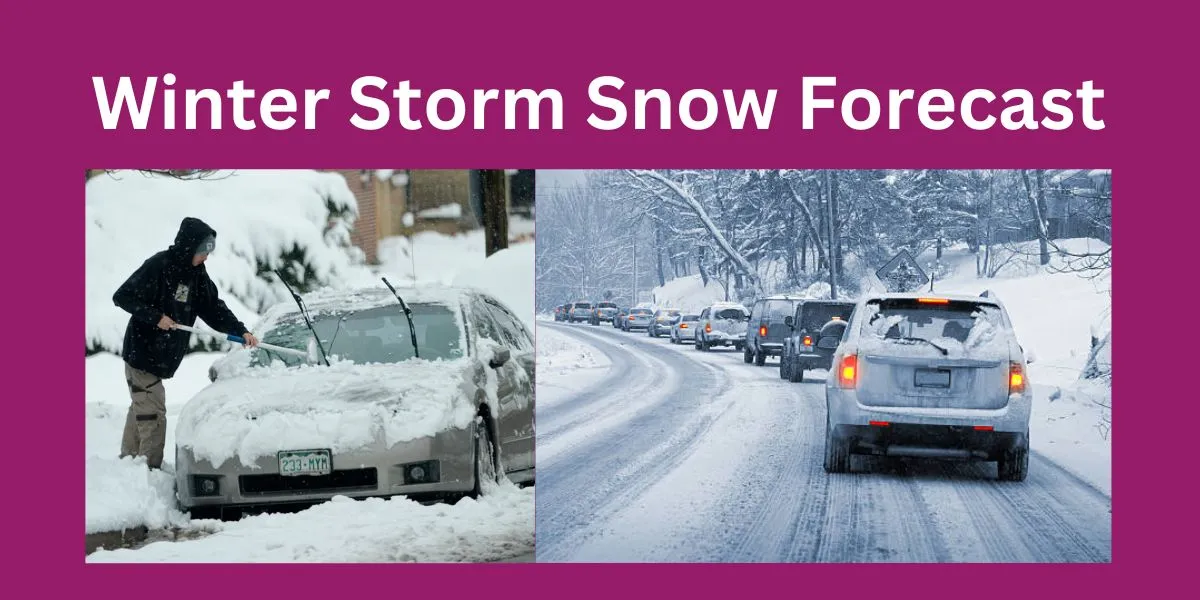Winter storms can be magical with their snow-covered landscapes, but they also come with challenges. Whether you’re cozying up by the fire or prepping for an icy blast, knowing what to expect from a winter storm is crucial. Let’s dive into what a winter storm snow forecast means, how it’s determined, and how you can prepare for the next big freeze.
What Is a Winter Storm Snow Forecast?
A winter storm snow forecast is a prediction of snowfall, icy conditions, and other weather elements associated with a winter storm. It gives us an idea of how much snow to expect, when it will fall, and how severe conditions might be.
Why Are Winter Storm Forecasts Important?
Winter storms don’t just bring a beautiful blanket of snow—they can also disrupt travel, power lines, and daily life. Accurate forecasts help us prepare and avoid the worst of these disruptions.
How Do Meteorologists Predict Winter Storms?
The Science Behind Snow Forecasting
Ever wonder how meteorologists know when a storm is coming? It’s not magic—it’s a mix of science, technology, and a bit of experience.
Satellite Data and Radar Imaging
Meteorologists rely on satellite data and radar imaging to track weather patterns. These tools provide real-time images of storm systems moving across the globe.
Weather Models
Supercomputers run complex weather models that predict how storm systems will evolve. These models crunch data like temperature, air pressure, and moisture to forecast snowfall.
Historical Data
Past weather patterns often help forecasters predict future storms. If similar conditions have led to heavy snow before, there’s a good chance they will again.
Factors That Affect Snowfall Predictions
Snowfall isn’t just about cold air—several factors come into play.
Temperature
The sweet spot for snow is between 28°F and 32°F. Too warm, and you’ll get rain. Too cold, and the air may not hold enough moisture for significant snow.
Moisture Content in the Air
No moisture, no snow. The amount of water vapor in the atmosphere determines how much snow a storm will produce.
Wind Patterns
Wind can carry moisture into storm systems or drive it away. Strong winds can also create dangerous conditions like blizzards.
Terrain
Mountains and valleys can dramatically affect snowfall. For example, higher elevations often see more snow because temperatures are colder.
Different Types of Winter Storms
Not all winter storms are created equal. Here’s a quick rundown:
Snowstorms
These storms bring heavy snow and can last several hours or even days.
Blizzards
Blizzards are intense snowstorms with strong winds and low visibility. Think of them as the overachievers of winter weather.
Ice Storms
Ice storms occur when freezing rain coats surfaces in a layer of ice. They’re beautiful but dangerous.
Lake-Effect Snow
If you live near a large lake, you’ve likely experienced lake-effect snow. Cold air moves over warm lake water, creating intense snowfall.
How to Prepare for a Winter Storm
Preparation is key to staying safe during a winter storm. Here’s your checklist:
Stock Up on Essentials
Nobody wants to be caught in a storm without supplies. Make sure you have:
- Non-perishable food
- Bottled water
- Flashlights and batteries
- Warm clothing and blankets
Check Your Heating System
Ensure your heating system is working efficiently. A cold night without heat is no joke.
Winterize Your Car
If you need to drive, make sure your car is winter-ready. This includes checking your tires, topping off antifreeze, and keeping an emergency kit in your vehicle.
Stay Informed
Keep an eye on the weather forecast and alerts. Apps, websites, and local news are your best friends during storm season.
During the Storm: Safety First
When the snow starts falling, staying safe should be your top priority.
Stay Indoors
If possible, avoid going outside. High winds and icy roads can be hazardous.
Use Space Heaters Safely
If you’re using a space heater, follow the manufacturer’s guidelines. Keep it away from flammable materials and never leave it unattended.
Avoid Overexertion
Shoveling snow can be hard work. Take breaks and don’t push yourself too hard.
Fun Things to Do During a Snowstorm
A snowstorm isn’t all doom and gloom. It’s also a great time to enjoy some cozy activities.
Have a Movie Marathon
What better time to catch up on your favorite films?
Try a New Recipe
Bake cookies, whip up a hearty stew, or make hot chocolate. Winter storms are perfect for comfort food.
Build a Snowman
If it’s safe to go outside, channel your inner child and build a snowman or have a snowball fight.
How Winter Storms Impact Daily Life
Winter storms can be disruptive, but they also teach us to adapt.
School and Work Closures
Snow days aren’t just for kids. Many workplaces and schools close during severe storms.
Transportation Delays
Flights, trains, and buses are often delayed or canceled due to snow and ice.
Power Outages
Heavy snow and ice can bring down power lines, leaving thousands without electricity.
How to Stay Positive During a Winter Storm
It’s easy to feel cooped up during a snowstorm, but staying positive can make a big difference.
Embrace the Downtime
Think of a winter storm as a mini-vacation. Use the time to relax, read, or catch up on hobbies.
Connect with Loved Ones
A storm is a great excuse to call or video chat with family and friends.
Plan for the Future
Use the quiet time to set goals, plan trips, or organize your space.
Conclusion
Winter storms are a mix of beauty and chaos. While they can disrupt our routines, they also offer an opportunity to slow down and appreciate the season. By staying informed and prepared, you can enjoy the snowy wonderland without the stress.
FAQs
1. How accurate are winter storm snow forecasts?
Forecasts are usually accurate within a few days but become less reliable the further out they predict.
2. What should I do if I lose power during a winter storm?
Use flashlights, layer up to stay warm, and avoid opening your fridge to keep food fresh.
3. Can I drive during a snowstorm?
It’s best to avoid driving unless absolutely necessary. If you must, drive slowly and carefully.
4. What’s the difference between a snowstorm and a blizzard?
Blizzards have strong winds and low visibility, while snowstorms are less intense.
5. How do I find out about school closures during a storm?
Check local news, school district websites, or weather apps for updates.










